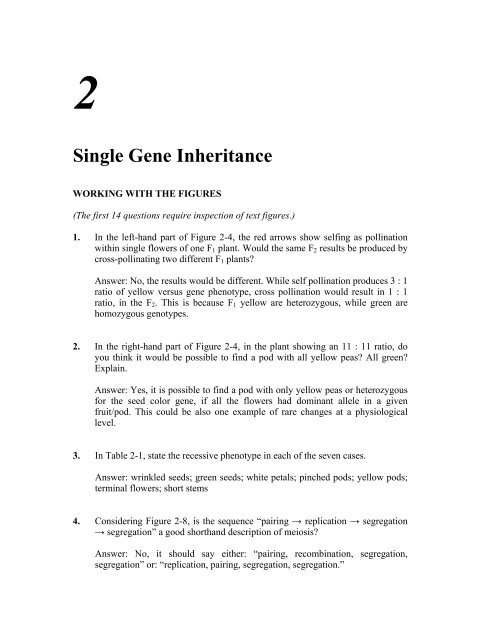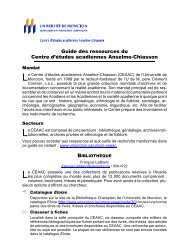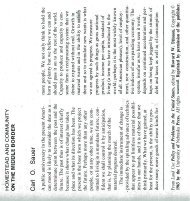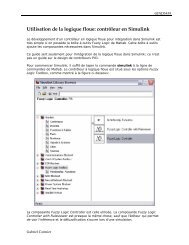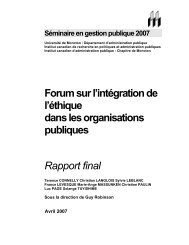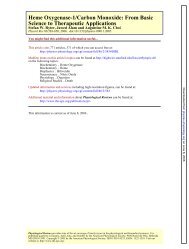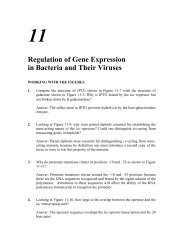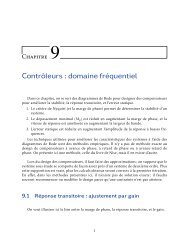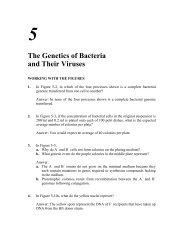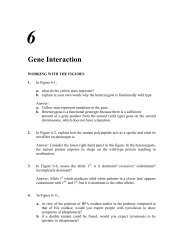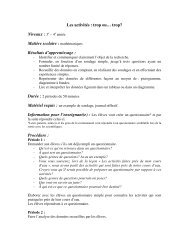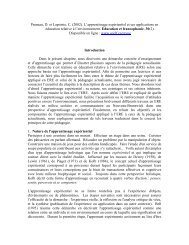IGA 8/e Chapter 2
IGA 8/e Chapter 2
IGA 8/e Chapter 2
You also want an ePaper? Increase the reach of your titles
YUMPU automatically turns print PDFs into web optimized ePapers that Google loves.
2Single Gene InheritanceWORKING WITH THE FIGURES(The first 14 questions require inspection of text figures.)1. In the left-hand part of Figure 2-4, the red arrows show selfing as pollinationwithin single flowers of one F 1 plant. Would the same F 2 results be produced bycross-pollinating two different F 1 plants?Answer: No, the results would be different. While self pollination produces 3 : 1ratio of yellow versus gene phenotype, cross pollination would result in 1 : 1ratio, in the F 2 . This is because F 1 yellow are heterozygous, while green arehomozygous genotypes.2. In the right-hand part of Figure 2-4, in the plant showing an 11 : 11 ratio, doyou think it would be possible to find a pod with all yellow peas? All green?Explain.Answer: Yes, it is possible to find a pod with only yellow peas or heterozygousfor the seed color gene, if all the flowers had dominant allele in a givenfruit/pod. This could be also one example of rare changes at a physiologicallevel.3. In Table 2-1, state the recessive phenotype in each of the seven cases.Answer: wrinkled seeds; green seeds; white petals; pinched pods; yellow pods;terminal flowers; short stems4. Considering Figure 2-8, is the sequence “pairing → replication → segregation→ segregation” a good shorthand description of meiosis?Answer: No, it should say either: “pairing, recombination, segregation,segregation” or: “replication, pairing, segregation, segregation.”
<strong>Chapter</strong> Two 75. Point to all cases of bivalents, dyads, and tetrads in Figure 2-11.Answer: Replicate sister chromosomes or dyads are at any chromatid after thereplication (S phase). A pair of synapsed dyads is called a bivalent and it wouldrepresent two dyads together (sister chromatids on the right), while the fourchromatids that make up a bivalent are called a tetrad and they would be theentire square (with same or different alleles on the bivalents).6. In Figure 2-12, assume (as in corn plants) that A encodes an allele that producesstarch in pollen and allele a does not. Iodine solution stains starch black. Howwould you demonstrate Mendel’s first law directly with such a system?Answer: One would use this iodine dye to color the starch producing cornpollen. Since pollen is a plant gametophyte generation (haploid) it will beproduced by meiosis. Mendel’s first law predicts segregation of alleles intogametes, therefore we would expect 1 : 1 ratio of starch producing (A) versusnon-starch producing (a) pollen grains, from a heterozygous (A/a) parent/maleflower. It would be easy to color the pollen and count the observed ratio.7. In the text figure on page 43, assume the left-hand individual is selfed. Whatpattern of radioactive bands would you see in a Southern analysis of theprogeny?Answer: If an individual is selfed, the restriction fragments should be identicalto the parents fragments. In this case, a heterozygous parent to the left had threebands (two from a mutant allele “a” and one from dominant allele “A”).8. Considering Figure 2-15, if you had a homozygous double mutant m3/m3m5/m5, would you expect it to be mutant in phenotype? (Note: This line wouldhave two mutant sites in the same coding sequence.)Answer: Yes, this double mutant m3/m3 and m5/m5 would be a null mutation,because m3 mutation changes the exon sequence.9. In which of the stages of the Drosophila life cycle (represented in the box onpage 52) does meiosis take place?Answer: Meiosis happens in adult ovaries and testes, therefore beforefertilization. After fertilization, fruit flies would lay their eggs (with nowdiploid embryos). That would be Stage 1 on the figure.
8 <strong>Chapter</strong> Two10. If you assume Figure 2-17 also applies to mice and you irradiate male spermwith X rays (known to inactivate genes), what phenotype would you look for inprogeny in order to find cases of individuals with an inactivated SRY gene?Answer: If we inactivate the SRY gene in mammals with radiation, the offspringshould all be phenotypically females, yet on the chromosome level there wouldbe both XX and XY (in this case sterile, female looking males).11. In Figure 2-19, how does the 3 : 1 ratio in the bottom-left-hand grid differ fromthe 3 : 1 ratios obtained by Mendel?Answer: It differs because in Mendel’s experiments, we learned aboutautosomal genes, while in this case we have a sex linked gene for eye color.3 : 1 ratio means that all females have red eyes (X +/– ), while half the males havered (X + /Y) and half white (X W /Y).Careful sex determination when counting F 2 offspring would point out to a sexlinked trait.12. In Figure 2-21, assume that the pedigree is for mice, in which any chosen crosscan be made. If you bred IV-1 with IV-3, what is the probability that the firstbaby will show the recessive phenotype?Answer: The answer would be:2/3 2/3 1/4 = 1/9 or 0.11Probability that IV 1 and IV 3 mice are heterozygous is 2/3. This is becauseboth of their parents are known heterozygotes (A/a) and since they are dominantphenotype they could only be A/A or A/a. Now, probability that twoheterozygotes have a recessive homozygote offspring is 1/4.13. Which part of the pedigree in Figure 2-23 in your opinion best demonstratesMendel’s first law?Answer: Any part of this pedigree demonstrates the law, showing segregation ofalleles into gametes. The middle part of generation II marriage shows a typicaltest cross (expected 1:1). Neither ratio in the pedigree could be confirmedbecause of a small sample size in any given family, but allele segregation isobvious.14. Could the pedigree in Figure 2-31 be explained as an autosomal dominantdisorder? Explain.
<strong>Chapter</strong> Two 9Answer: Yes, it could in some cases, but in this case we have clues that thepedigree is for a sex linked dominant trait. First, if fathers have a gene,daughters will receive it only, and second, if mother has a gene, both sons anddaughters would receive it.BASIC PROBLEMS15. Make up a sentence including the words chromosome, genes, and genome.Answer: The human genome contains an estimated 20,000–25,000 geneslocated on 23 different chromosomes.16. Peas (Pisum sativum) are diploid and 2n = 14. In Neurospora, the haploidfungus, n = 7. If it were possible to fractionate genomic DNA from both speciesby using pulsed field electrophoresis, how many distinct DNA bands would bevisible in each species?Answer: PFGE separates DNA molecules by size. When DNA is carefullyisolated from Neurospora (which has seven different chromosomes) sevenbands should be produced using this technique. Similarly, the pea has sevendifferent chromosomes and will produce seven bands (homologouschromosomes will co-migrate as a single band).17. The broad bean (Vicia faba) is diploid and 2n = 18. Each haploid chromosomeset contains approximately 4 m of DNA. The average size of each chromosomeduring metaphase of mitosis is 13 m. What is the average packing ratio ofDNA at metaphase? (Packing ratio = length of chromosome/length of DNAmolecule therein.) How is this packing achieved?Answer: There is a total of 4 m of DNA and nine chromosomes per haploid set.On average, each is 4 / 9 m long. At metaphase, their average length is 13 µm, sothe average packing ratio is 13 10 –6 m : 4.4 10 –1 m or roughly 1 : 34,000!This remarkable achievement is accomplished through the interaction of theDNA with proteins. At its most basic, eukaryotic DNA is associated withhistones in units called nucleosomes and during mitosis, coils into a solenoid.As loops, it associates with and winds into a central core of nonhistone proteincalled the scaffold.18. If we call the amount of DNA per genome “x,” name a situation or situations indiploid organisms in which the amount of DNA per cell is:a. x b. 2x c. 4x
10 <strong>Chapter</strong> TwoAnswer: Because the DNA levels vary four-fold, the range covers cells that arehaploid (gametes) to cells that are dividing (after DNA has replicated but priorto cell division). The following cells would fit the DNA measurements:haploid cells2x diploid cells in G 1 or cells after meiosis I but prior to meiosis II4x diploid cells after S but prior to cell divisionx +19. Name the key function of mitosis.Answer: The key function of mitosis is to generate two daughter cellsgenetically identical to the original parent cell.20. Name two key functions of meiosis.Answer: Two key functions of meiosis are to halve the DNA content and toreshuffle the genetic content of the organism to generate genetic diversityamong the progeny.21. Can you design a different nuclear-division system that would achieve the sameoutcome as that of meiosis?Answer: It’s pretty hard to beat several billions of years of evolution, but itmight be simpler if DNA did not replicate prior to meiosis. The same eventsresponsible for halving the DNA and producing genetic diversity could beachieved in a single cell division if homologous chromosomes paired,recombined, randomly aligned during metaphase, and separated duringanaphase, etc. However, you would lose the chance to check and repair DNAthat replication allows.22. In a possible future scenario, male fertility drops to zero, but, luckily, scientistsdevelop a way for women to produce babies by virgin birth. Meiocytes areconverted directly (without undergoing meiosis) into zygotes, which implant inthe usual way. What would be the short- and long-term effects in such asociety?Answer: In large part, this question is asking, why sex? Parthenogenesis (theability to reproduce without fertilization—in essence, cloning) is not commonamong multicellular organisms. Parthenogenesis occurs in some species oflizards and fishes, and several kinds of insects, but it is the only means ofreproduction in only a few of these species. In plants, about 400 species canreproduce asexually by a process called apomixis. These plants produce seedswithout fertilization. However, the majority of plants and animals reproduce
<strong>Chapter</strong> Two 11sexually. Sexual reproduction produces a wide variety of different offspring byforming new combinations of traits inherited from both the father and themother. Despite the numerical advantages of asexual reproduction, mostmulticellular species that have adopted it as their only method of reproducinghave become extinct. However, there is no agreed upon explanation of why theloss of sexual reproduction usually leads to early extinction or conversely, whysexual reproduction is associated with evolutionary success.On the other hand, the immediate effects of such a scenario are obvious. Alloffspring will be genetically identical to their mothers, and males would beextinct within one generation.23. In what ways does the second division of meiosis differ from mitosis?Answer: As cells divide mitotically, each chromosome consists of identicalsister chromatids that are separated to form genetically identical daughter cells.Although the second division of meiosis appears to be a similar process, the“sister” chromatids are likely to be different. Recombination during earliermeiotic stages has swapped regions of DNA between sister and nonsisterchromosomes such that the two daughter cells of this division typically are notgenetically identical.24. Make up mnemonics for remembering the five stages of prophase I of meiosisand the four stages of mitosis.Answer: The four stages of mitosis are: prophase, metaphase, anaphase, andtelophase. The first letters, PMAT, can be remembered by a mnemonic such as:Playful Mice Analyze Twice.The five stages of prophase I are: leptotene, zygotene, pachytene, diplotene, anddiakinesis. The first letters, LZPDD, can be remembered by a mnemonic suchas: Large Zoos Provide Dangerous Distractions.25. In an attempt to simplify meiosis for the benefit of students, mad scientistsdevelop a way of preventing premeiotic S phase and making do with having justone division, including pairing, crossing over, and segregation. Would thissystem work, and would the products of such a system differ from those of thepresent system?Answer: Yes, it could work but certain DNA repair mechanisms (such aspostreplication recombination repair) could not be invoked prior to cell division.There would be just two cells as products of this meiosis, rather than four.26. Theodor Boveri said, “The nucleus doesn’t divide; it is divided.” What was hegetting at?
12 <strong>Chapter</strong> TwoAnswer: The nucleus contains the genome and separates it from the cytoplasm.However, during cell division, the nuclear envelope dissociates (breaks down).It is the job of the microtubule-based spindle to actually separate thechromosomes (divide the genetic material) around which nuclei reform duringtelophase. In this sense, it can be viewed as a passive structure that is divided bythe cell’s cytoskeleton.27. Francis Galton, a geneticist of the pre-Mendelian era, devised the principle thathalf of our genetic makeup is derived from each parent, one-quarter from eachgrandparent, one-eighth from each great-grandparent, and so forth. Was heright? Explain.Answer: Yes, half of our genetic makeup is derived from each parent, eachparent’s genetic makeup is derived half from each of their parents, etc.28. If children obtain half their genes from one parent and half from the otherparent, why aren’t siblings identical?Answer: Because the “half” inherited is very random, the chances of receivingexactly the same half is vanishingly small. Ignoring recombination and focusingjust on which chromosomes are inherited from one parent (for example, the onethey inherited from their father or the one from their mother?), there are 2 23 =8,388,608 possible combinations!29. State where cells divide mitotically and where they divide meiotically in a fern,a moss, a flowering plant, a pine tree, a mushroom, a frog, a butterfly, and asnail.Answer:fernmossMitosissporophytegametophytesporophytegametophyteMeiosis(sporangium)plant sporophytegametophytepine tree sporophytegametophytemushroom sporophytegametophytefrog somatic cells gonadsbutterfly somatic cells gonadssporophyte(antheridium andarchegonium)sporophyte (antherand ovule)sporophyte (pinecone)sporophyte (ascus orbasidium)
<strong>Chapter</strong> Two 13snail somatic cells gonads30. Human cells normally have 46 chromosomes. For each of the following stages,state the number of nuclear DNA molecules present in a human cell:a. metaphase of mitosis.b. metaphase I of meiosis.c. telophase of mitosis.d. telophase I of meiosis.e. telophase II of meiosis.Answer: This problem is tricky because the answers depend on how a cell isdefined. In general, geneticists consider the transition from one cell to two cellsto occur with the onset of anaphase in both mitosis and meiosis, even thoughcytoplasmic division occurs at a later stage.a. 46 chromosomes, each with two chromatids = 92 chromatidsb. 46 chromosomes, each with two chromatids = 92 chromatidsc. 46 physically separate chromosomes in each of two about-to-be-formedcellsd. 23 chromosomes in each of two about-to-be-formed cells, each with twochromatids = 46 chromatidse. 23 chromosomes in each of two about-to-be-formed cells31. Four of the following events are part of both meiosis and mitosis, but only oneis meiotic. Which one? (1) chromatid formation, (2) spindle formation, (3)chromosome condensation, (4) chromosome movement to poles, (5) synapsis.Answer: (5) chromosome pairing (synapsis)32. In corn, the allele ƒ´ causes floury endosperm and the allele f´´ causes flintyendosperm. In the cross ƒ´/ƒ´ [female symbol] ƒ´´/ƒ´´ [male symbol], all theprogeny endosperms are floury, but in the reciprocal cross, all the progenyendosperms are flinty. What is a possible explanation? (Check the legend forFigure 2-7.)Answer: First, examine the crosses and the resulting genotypes of theendosperm:Female Male Polar Sperm Endospermnucleiƒ´/ƒ´ ƒ´´/ƒ´´ ƒ´ and ƒ´ ƒ´´/ƒ´´ ƒ´/ƒ´/ƒ´´(floury)ƒ´´/ƒ´´ ƒ´/ƒ´ ƒ´´ and ƒ´´ ƒ´/ƒ´ ƒ´´/ƒ´´/ƒ´(flinty)
14 <strong>Chapter</strong> TwoAs can be seen, the phenotype of the endosperm correlates to the predominantallele present.33. What is Mendel’s first law?Answer: Mendel’s first law states that alleles segregate into gametes duringmeiosis. This discovery came from his monohybrid experimental crosses.34. If you had a fruit fly (Drosophila melanogaster) that was of phenotype A, whattest would you make to determine if the fly’s genotype was A/A or A/a?Answer: Do a test-cross (cross to a/a). If the fly was A/A, all the progeny will bephenotypically A; if the fly was A/a, half the progeny will be A, and half will bea.35. In examining a large sample of yeast colonies on a petri dish, a geneticist findsan abnormal-looking colony that is very small. This small colony was crossedwith wild type, and products of meiosis (ascospores) were spread on a plate toproduce colonies. In total, there were 188 wild-type (normal-size) colonies and180 small ones.a. What can be deduced from these results regarding the inheritance of thesmall-colony phenotype? (Invent genetic symbols.)b. What would an ascus from this cross look like?Answer:a. A diploid meiocyte that is heterozygous for one gene (for example, s + /swhere s is the allele that confers the small colony phenotype) will, afterreplication and segregation, give two meiotic products of genotype s + andtwo of s. If the random spores of many meiocytes are analyzed, you wouldexpect to find about 50 percent normally sized colonies and 50 percent smallcolonies if the abnormal phenotype is the result of a mutation in a singlegene. Thus, the actual results of 188 normally sized and 180 small-sizedcolonies support the hypothesis that the phenotype is the result of a mutationin a single gene.b. The following represents an ascus with four spores. The important detail isthat two of the spores are s and two are s + .ss +s s +
<strong>Chapter</strong> Two 1536. Two black guinea pigs were mated and over several years produced 29 blackand 9 white offspring. Explain these results, giving the genotypes of parents andprogeny.Answer: The progeny ratio is approximately 3:1, indicating classicheterozygous-by-heterozygous mating. Since black (B) is dominant to white (b):Parents: B/b B/bProgeny: 3 black:1 white (1 B/B : 2 B/b : 1 b/b)This ratio indicates that black parents were probably heterozygous and thatblack is dominant over white.37. In a fungus with four ascospores, a mutant allele lys-5 causes the ascosporesbearing that allele to be white, whereas the wild-type allele lys-5+ results inblack ascospores. (Ascospores are the spores that constitute the four products ofmeiosis.) Draw an ascus from each of the following crosses:a. lys-5 lys-5+b. lys-5 lys-5c. lys-5+ lys-5+Answer:a. You expect two lys-5 + (black) spores and two lys-5 (white) spores.b. You expect all lys-5 (white) spores.c. You expect all lys-5 + (black) spores.38. For a certain gene in a diploid organism, eight units of protein product areneeded for normal function. Each wild-type allele produces five units.a. If a mutation creates a null allele, do you think this allele will be recessiveor mutant?
16 <strong>Chapter</strong> Twob. What assumptions need to be made to answer part a?Answer:a. You do not expect the mutation to be recessive. This would be an exampleof a haploinsufficient gene since one copy of the wild-type allele doesproduce enough protein product for normal function.b. An important assumption would be that having five of eight units of proteinproduct would result in an observable phenotype. It also assumes that theregulation of the single wild-type allele is not affected. Finally, if the mutantallele was leaky rather than null, there might be sufficient protein functionwhen heterozygous with a wild-type allele.39. A Neurospora colony at the edge of a plate seemed to be sparse (low density) incomparison with the other colonies on the plate. This colony was thought to bea possible mutant, and so it was removed and crossed with a wild type of theopposite mating type. From this cross, 100 ascospore progeny were obtained.None of the colonies from these ascospores was sparse, all appearing to benormal. What is the simplest explanation of this result? How would you testyour explanation? (Note: Neurospora is haploid.)Answer: The simplest explanation is that the abnormal phenotype was not dueto an genetic change. Perhaps the environment (edge of plate) was lessfavorable for growth. Since Neurospora is haploid and forms ascospores,isolating individual asci from a cross of the possible “mutant” to wild type andindividually growing the spores should yield 50 percent wild-type and 50percent “mutant” colonies. If all spores yield wild-type colonies, the low densityphenotype was not heritable.40. From a large-scale screen of many plants of Collinsia grandiflora, a plant withthree cotyledons was discovered (normally, there are two cotyledons). Thisplant was crossed with a normal pure-breeding wild-type plant, and 600 seedsfrom this cross were planted. There were 298 plants with two cotyledons and302 with three cotyledons. What can be deduced about the inheritance of threecotyledons? Invent gene symbols as part of your explanation.Answer: Since half of the F 1 progeny are mutant, it suggests that the mutationthat results in three cotyledons is dominant, and the original mutant washeterozygous. Assuming C = the mutant allele and c = the wild-type allele, thecross becomes:P C/c c/cF 1 C/c three cotyledonsc/c two cotyledons41. In the plant Arabidopsis thaliana, a geneticist is interested in the development
<strong>Chapter</strong> Two 17of trichomes (small projections). A large screen turns up two mutant plants (Aand B) that have no trichomes, and these mutants seem to be potentially usefulin studying trichome development. (If they were determined by single-genemutations, then finding the normal and abnormal functions of these geneswould be instructive.) Each plant is crossed with wild type; in both cases, thenext generation (F 1 ) had normal trichomes. When F 1 plants were selfed, theresulting F 2 ’s were as follows:F 2 from mutant A: 602 normal; 198 no trichomesF 2 from mutant B: 267 normal; 93 no trichomesa. What do these results show? Include proposed genotypes of all plants inyour answer.b. Under your explanation to part a, is it possible to confidently predict the F 1from crossing the original mutant A with the original mutant B?Answer:a. The data for both crosses suggest that both A and B mutant plants arehomozygous for recessive alleles. Both F 2 crosses give 3:1 ratios of normalto mutant progeny. For example, let A = normal and a = mutant, thenP A / A a/aF 1 A/aF 2 1 A/A phenotype: normal2 A/a phenotype: normal1 a a phenotype: mutant (no trichomes).b. No. You do not know if the a and b mutations are in the same or differentgenes. If they are in the same gene then the F 1 will all be mutant. If they arein different genes, then the F 1 will all be wild type.42. You have three dice: one red (R), one green (G), and one blue (B). When allthree dice are rolled at the same time, calculate the probability of the followingoutcomes:a. 6 (R), 6 (G), 6 (B)b. 6 (R), 5 (G), 6 (B)c. 6 (R), 5 (G), 4 (B)d. No sixes at alle. A different number on all diceAnswer: Each die has six sides, so the probability of any one side (number) is1 / 6 . To get specific red, green, and blue numbers involves “and” statements thatare independent. So each independent probability is multiplied together.a. ( 1 / 6 )( 1 / 6 )( 1 / 6 ) = ( 1 / 6 ) 3 = 1 / 216b. ( 1 / 6 )( 1 / 6 )( 1 / 6 ) = ( 1 / 6 ) 3 = 1 / 216c. ( 1 / 6 )( 1 / 6 )( 1 / 6 ) = ( 1 / 6 ) 3 = 1 / 216d. To not roll any sixes is the same as getting anything but sixes:
18 <strong>Chapter</strong> Two(1 – 1 / 6 )(1 – 1 / 6 )(1 – 1 / 6 ) = ( 5 / 6 ) 3 = 125 / 216.e. The easiest way to approach this problem is to consider each die separately.The first die thrown can be any number. Therefore, the probability for it is1.The second die can be any number except the number obtained on the firstdie. Therefore, the probability of not duplicating the first die is 1 – p(firstdie duplicated) = 1 – 1 / 6 = 5 / 6 .The third die can be any number except the numbers obtained on the firsttwo dice. Therefore, the probability is 1 – p(first two dice duplicated) = 1 –2 / 6 = 2 / 3 .Finally, the probability of all different dice is (1)( 5 / 6 )( 2 / 3 ) = 10 / 18 = 5 / 9 .43. In the pedigree below, the black symbols represent individuals with a very rareblood disease.If you had no other information to go on, would you think it more likely that thedisease was dominant or recessive? Give your reasons.Answer: You are told that the disease being followed in this pedigree is veryrare. If the allele that results in this disease is recessive, then the father wouldhave to be homozygous and the mother would have to be heterozygous for thisallele. On the other hand, if the trait is dominant, then all that is necessary toexplain the pedigree is that the father is heterozygous for the allele that causesthe disease. This is the better choice as it is more likely, given the rarity of thedisease.44. a. The ability to taste the chemical phenylthiocarbamide is an autosomaldominant phenotype, and the inability to taste it is recessive. If a tasterwoman with a nontaster father marries a taster man who in a previousmarriage had a nontaster daughter, what is the probability that their firstchild will be:(1) A nontaster girl(2) A taster girl(3) A taster boyb. What is the probability that their first two children will be tasters of eithersex?Answer:a. By considering the pedigree (see below), you will discover that the cross inquestion is T/t T/t. Therefore, the probability of being a taster is 3 / 4 , andthe probability of being a nontaster is 1 / 4 .
<strong>Chapter</strong> Two 19t/tT/t?T/tt/tAlso, the probability of having a boy equals the probability of having a girlequals 1 / 2 .(1) p(nontaster girl) = p(nontaster) p(girl) = 1 / 4 1 / 2 = 1 / 8(2) p(taster girl) = p(taster) p(girl) = 3 / 4 1 / 2 = 3 / 8(3) p(taster boy) = p(taster) p(boy) = 3 / 4 1 / 2 = 3 / 8b. p(taster for first two children) = p(taster for first child) p(taster for secondchild) = 3 / 4 3 / 4 = 9 / 1645. John and Martha are contemplating having children, but John’s brother hasgalactosemia (an autosomal recessive disease) and Martha’s great-grandmotheralso had galactosemia. Martha has a sister who has three children, none ofwhom have galactosemia. What is the probability that John and Martha’s firstchild will have galactosemia?Unpacking the Problem1. Can the problem be restated as a pedigree? If so, write one.Answer: Yes. The pedigree is given below.g/gG/gG/gG/gG/–g/gG/–JohnG/–Martha?2. Can parts of the problem be restated by using Punnett squares?Answer: In order to state this problem as a Punnett square, you must firstknow the genotypes of John and Martha. The genotypes can bedetermined only through considering the pedigree. Even with the
20 <strong>Chapter</strong> Twopedigree, however, the genotypes can be stated only as G/– for both Johnand Martha.The probability that John is carrying the allele for galactosemia is 2 / 3 ,rather than the 1 / 2 that you might guess. To understand this, recall thatJohn’s parents must be heterozygous in order to have a child with therecessive disorder while still being normal themselves (the assumption ofnormalcy is based on the information given in the problem). John’sparents were both G/g. A Punnett square for their mating would be:FatherGgMotherGgG/GG/gG/gg/gThe cross is:P G/g G/gF 1 g/g John’s brotherG/– John (either G/G or G/g)The expected ratio of the F 1 is 1 G/G : 2 G/g : 1 g/g. Because John doesnot have galactosemia (an assumption based on the information given inthe problem), he can be either G/G or G/g, which occurs at a ratio of 1:2.Therefore, his probability of carrying the g allele is 2 / 3 .The probability that Martha is carrying the g allele is based on thefollowing chain of logic. Her great-grandmother had galactosemia, whichmeans that she had to pass the allele to Martha’s grandparent. Because theproblem states nothing with regard to the grandparent’s phenotype, it mustbe assumed that the grandparent was normal, or G/g. The probability thatthe grandparent passed it to Martha’s parent is 1 / 2 . Next, the probabilitythat Martha’s parent passed the allele to Martha is also 1 / 2 , assuming thatthe parent actually has it. Therefore, the probability that Martha’s parenthas the allele and passed it to Martha is 1 / 2 1 / 2 , or 1 / 4 .In summary:John p(G/G) = 1 / 3p(G/g) = 2 / 3Martha p(G/G) = 3 / 4p(G/g) = 1 / 4This information does not fit easily into a Punnett square.
<strong>Chapter</strong> Two 213. Can parts of the problem be restated by using branch diagrams?Answer: While the above information could be put into a branch diagram,it does not easily fit into one and overcomplicates the problem, just as aPunnett square would.4. In the pedigree, identify a mating that illustrates Mendel’s first law.Answer: The marriage between John’s parents illustrates Mendel’s firstlaw.5. Define all the scientific terms in the problem, and look up any other termsabout which you are uncertain.Answer: The scientific words in this problem are galactosemia,autosomal, and recessive.Galactosemia is a metabolic disorder characterized by the absence of theenzyme galactose-1-phosphate uridyl transferase, which results in anaccumulation of galactose. In the vast majority of cases, galactosemiaresults in an enlarged liver, jaundice, vomiting, anorexia, lethargy, andvery early death if galactose is not omitted from the diet (initially, thechild obtains galactose from milk).Autosomal refers to genes that are on the autosomes.Recessive means that in order for an allele to be expressed, it must be theonly form of the gene present in the organism.6. What assumptions need to be made in answering this problem?Answer: The major assumption is that if nothing is stated about a person’sphenotype, the person is of normal phenotype. Another assumption thatmay be of value, but is not actually needed, is that all people marrying intothese two families are normal and do not carry the allele for galactosemia.7. Which unmentioned family members must be considered? Why?Answer: The people not mentioned in the problem, but who must beconsidered, are John’s parents and Martha’s grandparent and parentdescended from her affected great-grandmother.
22 <strong>Chapter</strong> Two8. What statistical rules might be relevant, and in what situations can they beapplied? Do such situations exist in this problem?Answer: The major statistical rule needed to solve the problem is theproduct rule (the “and” rule). It is used to calculate the cumulativeprobabilities described in part 2 of this unpacked solution (e.g., What isthe probability that Martha’s parent inherited the galactosemia allele ANDpassed that allele onto Martha AND Martha will pass that allele on to herchild?).9. What are two generalities about autosomal recessive diseases in humanpopulations?Answer: Autosomal recessive disorders are assumed to be rare and tooccur equally frequently in males and females. They are also assumed tobe expressed if the person is homozygous for the recessive genotype.10. What is the relevance of the rareness of the phenotype under study inpedigree analysis generally, and what can be inferred in this problem?Answer: Rareness leads to the assumption that people who marry into afamily that is being studied do not carry the allele, which was assumed inentry (6) above.11. In this family, whose genotypes are certain and whose are uncertain?Answer: The only certain genotypes in the pedigree are John’s parents,John’s brother, and Martha’s great-grandmother and grandmother. Allother individuals have uncertain genotypes.12. In what way is John’s side of the pedigree different from Martha’s side?How does this difference affect your calculations?Answer: John’s family can be treated simply as a heterozygous-byheterozygouscross, with John having a 2 / 3 probability of being a carrier,while it is unknown if either of Martha’s parents carry the allele.Therefore Martha’s chance of being a carrier must be calculated as a seriesof probabilities.13. Is there any irrelevant information in the problem as stated?
<strong>Chapter</strong> Two 23Answer: The information regarding Martha’s sister and her children turnsout to be irrelevant to the problem.14. In what way is solving this kind of problem similar to solving problemsthat you have already successfully solved? In what way is it different?Answer: The problem contains a number of assumptions that have notbeen necessary in problem solving until now.15. Can you make up a short story based on the human dilemma in thisproblem?Answer: Many scenarios are possible in response to this question.Now try to solve the problem. If you are unable to do so, try to identify theobstacle and write a sentence or two describing your difficulty. Then go back tothe expansion questions and see if any of them relate to your difficulty.Solution to the ProblemAnswer: p(child has galactosemia) = p(John is G/g) p(Martha is G/g) p(bothparents passed g to the child) = ( 2 / 3 )( 1 / 4 )( 1 / 4 ) = 2 / 48 = 1 / 2446. Holstein cattle are normally black and white. A superb black-and-white bull,Charlie, was purchased by a farmer for $100,000. All the progeny sired byCharlie were normal in appearance. However, certain pairs of his progeny,when interbred, produced red-and-white progeny at a frequency of about 25percent. Charlie was soon removed from the stud lists of the Holstein breeders.Use symbols to explain precisely why.Answer: Charlie, his mate, or both, obviously were not homozygous for one ofthe alleles (pure-breeding), because his F 2 progeny were of two phenotypes. LetA = black and white, and a = red and white. If both parents were heterozygous,then red and white would have been expected in the F 1 generation. Red andwhite were not observed in the F 1 generation, so only one of the parents washeterozygous. The cross is:PF 1A/a A/A1 A/a : 1 A/ATwo F 1 heterozygotes (A/a) when crossed would give 1 A/A (black and white) :2 A/a (black and white) : 1 a/a (red and white). If the red and white F 2 progenywere from more than one mate of Charlie’s, then the farmer acted correctly.
<strong>Chapter</strong> Two 25Answer: The plants are approximately 3 blotched : 1 unblotched. This suggeststhat blotched is dominant to unblotched and that the original plant which wasselfed was a heterozygote.a. Let A = blotched, a = unblotched.P A/a (blotched) A/a (blotched)F 1 1 A/A : 2 A/a : 1 a/a3 A/– (blotched) : 1 a/a (unblotched)b. All unblotched plants should be pure-breeding in a testcross with anunblotched plant (a/a), and one-third of the blotched plants should bepure-breeding.49. Can it ever be proved that an animal is not a carrier of a recessive allele (that is,not a heterozygote for a given gene)? Explain.Answer: In theory, it cannot be proved that an animal is not a carrier for arecessive allele. However, in an A/– a/a cross, the more dominant-phenotypeprogeny produced, the less likely it is that the parent is A/a. In such a cross, halfthe progeny would be a/a and half would be A/a. With n dominant phenotypeprogeny, the probability that the parent is A/a is ( 1 / 2 ) n . (DNA sequencing can beused to prove heterozygosity, but without sequence level information, the levelof certainty is limited by sample size.)50. In nature, the plant Plectritis congesta is dimorphic for fruit shape; that is,individual plants bear either wingless or winged fruits, as shown in theillustration. Plants were collected from nature before flowering and werecrossed or selfed with the following results:Number of progenyPollination Winged WinglessWinged (selfed) 91 1*Winged (selfed) 90 30Wingless (selfed) 4* 80
26 <strong>Chapter</strong> TwoWinged × wingless 161 0Winged × wingless 29 31Winged × wingless 46 0Winged × winged 44 0Winged × winged 24 0*Phenotype probably has a nongenetic explanation.Interpret these results, and derive the mode of inheritance of these fruit-shapedphenotypes. Use symbols. What do you think is the nongenetic explanation forthe phenotypes marked by asterisks in the table?Answer: The results suggest that winged (A/–) is dominant to wingless (a/a)(cross 2 gives a 3 : 1 ratio). If that is correct, the crosses become:Number of progeny plantsPollination Genotypes Winged Winglesswinged (selfed) A/A A/A 91 1*winged (selfed) A/a A/a 90 30wingless (selfed) a/a a/a 4* 80winged wingless A/A a/a 161 0winged wingless A/a a/a 29 31winged wingless A/A a/a 46 0winged winged A/A A/– 44 0winged winged A/A A/– 24 0The five unusual plants are most likely due either to human error inclassification or to contamination. Alternatively, they could result fromenvironmental effects on development. For example, too little water may haveprevented the seed pods from becoming winged even though they aregenetically winged.51. The accompanying pedigree is for a rare, but relatively mild, hereditary disorderof the skin.
<strong>Chapter</strong> Two 27a. How is the disorder inherited? State reasons for your answer.b. Give genotypes for as many individuals in the pedigree as possible. (Inventyour own defined allele symbols.)c. Consider the four unaffected children of parents III-4 and III-5. In all fourchildprogenies from parents of these genotypes, what proportion isexpected to contain all unaffected children?Answer:a. The disorder appears to be dominant because all affected individuals havean affected parent. If the trait was recessive, then I-1, II-2, III-1, and III-8would all have to be carriers (heterozygous for the rare allele).b. Assuming dominance, the genotypes are:I : d/d, D/dII : D/d, d/d, D/d, d/dIII : d/d, D/d, d/d, D/d, d/d, d/d, D/d, d/dIV : D/d, d/d, D/d, d/d, d/d, d/d, d/d, D/d, d/dc. The mating is D/d d/d. The probability of an affected child (D/d) equals1 / 2 , and the probability of an unaffected child (d/d) equals 1 / 2 . Therefore, thechance of having four unaffected children (since each is an independentevent) is: 1 / 2 1 / 2 1 / 2 1 / 2 = 1 / 16 .52. Four human pedigrees are shown in the accompanying illustration. The blacksymbols represent an abnormal phenotype inherited in a simple Mendelianmanner.
28 <strong>Chapter</strong> Twoa. For each pedigree, state whether the abnormal condition is dominant orrecessive. Try to state the logic behind your answer.b. For each pedigree, describe the genotypes of as many persons as possible.Answer:a. Pedigree 1: The best answer is recessive because two unaffected individualshad affected progeny. Also, the disorder skips generations and appears in amating between two related individuals.Pedigree 2: The best answer is dominant because two affected parents havean unaffected child. Also, it appears in each generation, roughly half theprogeny are affected, and all affected individuals have an affected parent.Pedigree 3: The best answer is dominant, for many of the reasons stated forpedigree 2. Inbreeding, while present in the pedigree, does not allow anexplanation of recessive because it cannot account for individuals in thesecond or third generations.Pedigree 4: The best answer is recessive. Two unaffected individuals hadaffected progeny.b. Genotypes of pedigree 1:Generation I: A/–, a/aGeneration II: A/a, A/a, A/a, A/–, A/–, A/aGeneration III: A/a, A/a
<strong>Chapter</strong> Two 29Generation IV: a/aGenotypes of pedigree 2:Generation I: A/a, a/a, A/a, a/aGeneration II: a/a, a/a, A/a, A/a, a/a, a/a, A/a, A/a, a/aGeneration III: a/a, a/a, a/a, a/a, a/a, A/–, A/–, A/–, A/a, a/aGeneration IV: a/a, a/a, a/aGenotypes of pedigree 3:Generation I: A/–, a/aGeneration II: A/a, a/a, a/a, A/aGeneration III: a/a, A/a, a/a, a/a, A/a, a/aGeneration IV: a/a, A/a, A/a, A/a, a/a, a/aGenotypes of pedigree 4:Generation I: a/a, A/–, A/a, A/aGeneration II: A/a, A/a, A/a, a/a, A/–, a/a, A/–, A/–, A/–, A/–, A/–Generation III: A/a, a/a, A/a, A/a, a/a, A/a53. Tay-Sachs disease (infantile amaurotic idiocy) is a rare human disease in whichtoxic substances accumulate in nerve cells. The recessive allele responsible forthe disease is inherited in a simple Mendelian manner. For unknown reasons,the allele is more common in populations of Ashkenazi Jews of eastern Europe.A woman is planning to marry her first cousin, but the couple discovers thattheir shared grandfather’s sister died in infancy of Tay-Sachs disease.a. Draw the relevant parts of the pedigree, and show all the genotypes ascompletely as possible.b. What is the probability that the cousins’ first child will have Tay-Sachsdisease, assuming that all people who marry into the family are homozygousnormal?Answer:a. The pedigree isT/tT/tT/–t/tT/–T/–T/–?T/–
30 <strong>Chapter</strong> Twob. The probability that the child of the two first cousins will have Tay-Sachsdisease is a function of three probabilities: p(the woman is T/t) p(the manis T/t) p(both donate t);= ( 2 / 3 )( 1 / 2 )( 1 / 2 ) ( 2 / 3 )( 1 / 2 )( 1 / 2 ) 1 / 4 = 1 / 144To understand the probabilities of the first two events, see the discussion forproblem 8 part (2) of this chapter.54. The following pedigree was obtained for a rare kidney disease.a. Deduce the inheritance of this condition, stating your reasons.b. If persons 1 and 2 marry, what is the probability that their first child willhave the kidney disease?Answer:a. Autosomal recessive: affected individuals inherited the trait fromunaffected parents and a daughter inherited the trait from an unaffectedfather.b. Both parents must be heterozygous to have a 1 / 4 chance of having anaffected child. Parent 2 is heterozygous, since her father is homozygous forthe recessive allele and parent 1 has a 1 / 2 chance of being heterozygous,since his father is heterozygous because 1’s paternal grandmother wasaffected. Overall, 1 1 / 2 1 / 4 = 1 / 8 .55. This pedigree is for Huntington disease, a late-onset disorder of the nervoussystem. The slashes indicate deceased family members.
<strong>Chapter</strong> Two 31a. Is this pedigree compatible with the mode of inheritance for Huntingtondisease mentioned in the chapter?b. Consider two newborn children in the two arms of the pedigree, Susan in theleft arm and Alan in the right arm. Study the graph in Figure 2-24 and forman opinion on the likelihood that they will develop Huntington disease.Assume for the sake of the discussion that parents have children at age 25.Answer:a. Yes. It is inherited as an autosomal dominant trait.b. Susan is highly unlikely to have Huntington’s disease. Hergreat-grandmother (individual II-2) is 75 years old and has yet to develop it,when nearly 100 percent of people carrying the allele will have developedthe disease by that age. If her great-grandmother does not have it, Susancannot inherit it.Alan is somewhat more likely than Susan to develop Huntington’s disease.His grandfather (individual III-7) is only 50 years old, and approximately 20percent of the people with the allele have yet to develop the disease by thatage. Therefore, it can be estimated that the grandfather has a 10 percentchance of being a carrier (50 percent chance he inherited the allele from hisfather 20 percent chance he has not yet developed symptoms). If Alan’sgrandfather eventually develops Huntington’s disease, then there is aprobability of 50 percent that Alan’s father inherited it from him, and aprobability of 50 percent that Alan received that allele from his father.Therefore, Alan has a 1 / 10 1 / 2 1 / 2 = 1 / 40 current probability of developingHuntington’s disease and a 1 / 2 1 / 2 = 1 / 4 probability if his grandfathereventually develops it.
32 <strong>Chapter</strong> Two56. Consider the accompanying pedigree of a rare autosomal recessive disease,PKU.a. List the genotypes of as many of the family members as possible.b. If persons A and B marry, what is the probability that their first child willhave PKU?c. If their first child is normal, what is the probability that their second childwill have PKU?d. If their first child has the disease, what is the probability that their secondchild will be unaffected?(Assume that all people marrying into the pedigree lack the abnormal allele.)Answer:a. Assuming the trait is rare, expect that all individuals marrying into thepedigree do not carry the disease-causing allele.I : P/P, p/p, p/p, P/PII : P/P, P/p, P/p, P/p, P/pIII : P/P, P/–, P/–, P/PIV : P/–, P/–b. For their child to have PKU, both A and B must be carriers and both mustdonate the recessive allele.The probability that individual A has the PKU allele is derived fromindividual II-2. II-2 must be P/p since her father must be p/p. Therefore, theprobability that II-2 passed the PKU allele to individual III-2 is 1 / 2 . If III-2received the allele, the probability that he passed it to individual IV-1 (A) is1 / 2 . Therefore, the probability that A is a carrier is 1 / 2 1 / 2 = 1 / 4 .The probability that individual B has the allele goes back to the mating ofII-3 and II-4, both of whom are heterozygous. Their child, III-3, has a 2 / 3probability of having received the PKU allele and a probability of 1 / 2 of
<strong>Chapter</strong> Two 33passing it to IV-2 (B). Therefore, the probability that B has the PKU allele is2 / 3 1 / 2 = 1 / 3 .If both parents are heterozygous, they have a 1 / 4 chance of both passing thep allele to their child.p(child has PKU) = p(A is P/p) p(B is P/p) p(both parents donate p)1 / 4 1 / 3 1/ 4 = 1 / 48c. If the first child is normal, no additional information has been gained andthe probability that the second child will have PKU is the same as theprobability that the first child will have PKU, or 1 / 48 .d. If the first child has PKU, both parents are heterozygous. The probability ofhaving an affected child is now 1 / 4 , and the probability of having anunaffected child is 3 / 4 .57. A man has attached earlobes, whereas his wife has free earlobes. Their firstchild, a boy, has attached earlobes.a. If the phenotypic difference is assumed to be due to two alleles of a singlegene, is it possible that the gene is X-linked?b. Is it possible to decide if attached earlobes are dominant or recessive?Answer:a. Sons inherit their X chromosome from their mother. The mother hasearlobes, the son does not. If the allele for earlobes is dominant and theallele for lack of earlobes recessive, then the mother could be heterozygousfor this trait and the gene could be X-linked.b. It is not possible from the data given to decide which allele is dominant. Iflack of earlobes is dominant, then the father would be heterozygous and theson would have a 50 percent chance of inheriting the dominant “lack-ofearlobes”allele. If lack of earlobes is recessive, then the trait could beautosomal or X-linked, but in either case, the mother would beheterozygous.58. A rare recessive allele inherited in a Mendelian manner causes the diseasecystic fibrosis. A phenotypically normal man whose father had cystic fibrosismarries a phenotypically normal woman from outside the family, and the coupleconsider having a child.a. Draw the pedigree as far as described.b. If the frequency in the population of heterozygotes for cystic fibrosis is 1 in50, what is the chance that the couple’s first child will have cystic fibrosis?c. If the first child does have cystic fibrosis, what is the probability that thesecond child will be normal?
34 <strong>Chapter</strong> TwoAnswer:a. Let C stand for the normal allele and c stand for the allele that causes cysticfibrosis.C/–c/cC/c?C/–b. The man has a 100 percent probability of having the c allele. His wife, whois from the general population, has a 1 / 50 chance of having the c allele. Ifboth have the allele, then 1 / 4 of their children will have cystic fibrosis. Theprobability that their first child will have cystic fibrosis is:p(man has c) p(woman has c) p(both pass c to the child)1.0 1 / 50 1 / 4 = 1 / 200 = 0.005c. If the first child does have cystic fibrosis, then the woman is a carrier of thec allele. Because both parents are C/c, the chance that the second child willbe normal is the probability of a normal child in a heterozygous heterozygous mating, or 3 / 4 .59. The allele c causes albinism in mice (C causes mice to be black). The cross C/c c/c produces 10 progeny. What is the probability of all of them being black?Answer: The cross is C/c c/c so there is a 1 / 2 chance that a progeny would beblack (C/c ). Because each progeny’s genotype is independent of the others, thechance that all 10 progeny are black is ( 1 / 2 ) 10 .60. The recessive allele s causes Drosophila to have small wings and the s 1 allelecauses normal wings. This gene is known to be X linked. If a small-wingedmale is crossed with a homozygous wild-type female, what ratio of normal tosmall-winged flies can be expected in each sex in the F 1 ? If F 1 flies areintercrossed, what F 2 progeny ratios are expected? What progeny ratios arepredicted if F 1 females are backcrossed with their father?Answer:P s + /s + s/YF 1 1 / 2 s + /s normal female1 / 2 s + /Y normal male
<strong>Chapter</strong> Two 35s + /s s + /YF 2 1 / 4 s + /s + normal female1 / 4 s + /s normal female1 / 4 s + /Y normal male1 / 4 s/Y small wings maleP s + /s s/YProgeny 1 / 4 s + /snormal female1 / 4 s/s small wings female1 / 4 s + /Y normal male1 / 4 s/Y small wings male61. An X-linked dominant allele causes hypophosphatemia in humans. A man withhypophosphatemia marries a normal woman. What proportion of their sons willhave hypophosphatemia?Answer: Let H = hypophosphate and h = normal. The cross is H/Y h/h,yielding H/h (females) and h/Y (males). The answer is 0% because sons alwaysinherit an X chromosome from their mothers and a Y chromosome from theirfathers.62. Duchenne muscular dystrophy is sex linked and usually affects only males.Victims of the disease become progressively weaker, starting early in life.a. What is the probability that a woman whose brother has Duchenne’s diseasewill have an affected child?b. If your mother’s brother (your uncle) had Duchenne’s disease, what is theprobability that you have received the allele?c. If your father’s brother had the disease, what is the probability that you havereceived the allele?Answer:a. You should draw pedigrees for this question.D/YD/d?D/–d/Y
36 <strong>Chapter</strong> TwoThe “maternal grandmother” had to be a carrier, D/d. The probability thatthe woman inherited the d allele from her is 1 / 2 . The probability that shepasses it to her child is 1 / 2 . The probability that the child is male is 1 / 2 . Thetotal probability of the woman having an affected child is 1 / 2 1 / 2 1 / 2 =1 / 8 .b. The same pedigree as part (a) applies. The “maternal grandmother” had tobe a carrier, D/d. The probability that your mother received the allele is 1 / 2 .The probability that your mother passed it to you is 1 / 2 . The totalprobability is 1 / 2 1 / 2 = 1 / 4 .c.D/YD/dd/YD/Y?D/DBecause your father does not have the disease, you cannot inherit the allelefrom him. Therefore, the probability of inheriting an allele will be based onthe chance that your mother is heterozygous. Since she is “unrelated” to thepedigree, assume that this is zero.63. A recently married man and woman discover that each had an uncle withalkaptonuria, otherwise known as “black urine disease,” a rare disease causedby an autosomal recessive allele of a single gene. They are about to have theirfirst baby. What is the probability that their child will have alkaptonuria?Answer: For the recently married man and woman to each have an uncle withalkaptonuria means that each may have one parent (the parent related to theuncle) that is heterozygous for the disease-causing allele. Specifically, thisparent (and related uncle) must have had parents that were both heterozygousfor alkaptonuria. Any child of parents that are both heterozygous for a recessivetrait, but does not have that trait, has a 2 / 3 chance of being heterozygous.(Remember, if both parents are heterozygous, we expect a 1 : 2 : 1 ratio ofgenotypes, but once we know a person is not homozygous recessive, the onlypossibilities left are 1 (homozygous dominant) to 2 (heterozygous) or 2 / 3 chanceof being heterozygous. ) So the man and woman each have a 2 / 3 1 / 2 = 1 / 3 ofbeing carriers (heterozygous), and the chance of their having an affected childwould be 1 / 3 1 / 3 1 / 4 = 1 / 36 .64. The accompanying pedigree concerns an inherited dental abnormality,
<strong>Chapter</strong> Two 37amelogenesis imperfecta.a. What mode of inheritance best accounts for the transmission of this trait?b. Write the genotypes of all family members according to your hypothesis.Answer:a. Because none of the parents are affected, the disease must be recessive.Because the inheritance of this trait appears to be sex-specific, it is mostlikely X-linked. If it were autosomal, all three parents would have to becarriers, and by chance, only sons and none of the daughters inherited thetrait (which is quite unlikely).b. I A/Y, A/a, A/YII A/Y, A/–, a/Y, A/–, A/Y, a/Y, a/Y, A/–, a/Y, A/–65. A couple who are about to get married learn from studying their family historiesthat, in both their families, their unaffected grandparents had siblings withcystic fibrosis (a rare autosomal recessive disease).a. If the couple marries and has a child, what is the probability that the childwill have cystic fibrosis?b. If they have four children, what is the chance that the children will have theprecise Mendelian ratio of 3 : 1 for normal : cystic fibrosis?c. If their first child has cystic fibrosis, what is the probability that their nextthree children will be normal?Answer:a. This question is similar to question 49, but this time the discussion beginswith the grandparents rather than the parents. Again, given that a sibling isaffected with a recessive disease, the related unaffected brother/sister willhave a 2 / 3 chance of being heterozygous. In this case, that is one of thegrandparents of both the man and woman about to be married. Given this,the couple will both have a 2 / 3 1 / 2 1 / 2 = 1 / 6 chance of being carriers(heterozygous) and the chance of their having an affected child will be1 / 6 1 / 6 1 / 4 = 1 / 144 .b. If both parents are carriers, there is a 3 / 4 chance a child will be normal anda 1 / 4 chance a child will have cystic fibrosis. Each child is an independentevent, but since birth order is not considered, there are four ways to havethe desired outcome. The child with cystic fibrosis may be the first, second,third, or fourth so assuming the first is affected, the specified outcomewould be a 1 / 4 3 / 4 3 / 4 3 / 4 or a 27 / 256 chance. Now, taking intoaccount the four possible birth orders and the chance that both parents are
38 <strong>Chapter</strong> Twoheterozygous, the chance of an exact 3:1 ratio becomes 4 1 / 6 1 / 6 27 / 256 = 3 / 256 .c. In this case, knowing the first child has cystic fibrosis lets us now deducethat the parents must both be heterozygous. Given this, there is a 3 / 4 chancethan any future child will be normal. Since each is independent, the chancethat their next three are normal is simply 3 / 4 3 / 4 3 / 4 or 27 / 64 .66. A sex-linked recessive allele c produces a red–green color blindness in humans.A normal woman whose father was color blind marries a color-blind man.a. What genotypes are possible for the mother of the color-blind man?b. What are the chances that the first child from this marriage will be a colorblindboy?c. Of the girls produced by these parents, what proportion can be expected tobe color blind?d. Of all the children (sex unspecified) of these parents, what proportion can beexpected to have normal color vision?Answer:You should draw the pedigree before beginning.Xc/YXC/X–XC/Xc?Xc/Ya. X C /X c , X c /X cb. p(colorblind) p(male) = ( 1 / 2 )( 1 / 2 ) = 1 / 4c. The girls will be 1 normal (X C /X c ) : 1 colorblind (X c /X c ).d. The cross is X C /X c X c /Y, yielding 1 normal : 1 colorblind for both sexes.67. Male house cats are either black or orange; females are black, orange, or calico.a. If these coat-color phenotypes are governed by a sex-linked gene, how canthese observations be explained?b. Using appropriate symbols, determine the phenotypes expected in theprogeny of a cross between an orange female and a black male.c. Half the females produced by a certain kind of mating are calico, and halfare black; half the males are orange, and half are black. What colors are theparental males and females in this kind of mating?d. Another kind of mating produces progeny in the following proportions: onefourthorange males, one-fourth orange females, one-fourth black males, andone-fourth calico females. What colors are the parental males and females inthis kind of mating?
<strong>Chapter</strong> Two 39Answer:a. This problem involves X-inactivation. Let B = black and b = orange.FemalesMalesX B /X B = black X B /Y = blackX b /X b = orange X b /Y = orangeX B /X b = calicob. P X b /X b (orange) X B /Y (black)F 1 X B /X b (calico female)X b /Y (orange male)c. Because the males are black or orange, the mother had to have been calico.Half the daughters are black, indicating that their father was black.d. Males were orange or black, indicating that the mothers were calico. Orangefemales indicate that the father was orange.68. The pedigree below concerns a certain rare disease that is incapacitating but notfatal.a. Determine the most likely mode of inheritance of this disease.b. Write the genotype of each family member according to your proposedmode of inheritance.c. If you were this family’s doctor, how would you advise the three couples inthe third generation about the likelihood of having an affected child?Answer:a. Recessive (unaffected parents have affected progeny) and X-linked (onlyassumption is that the grandmother, I-2, is a carrier). If autosomal, then I-1,I-2, and II-6 would all have to be carriers.b. Generation I: X A /Y, X A /X aGeneration II: X A /X A , X a /Y, X A Y, X A /X – , X A /X a , X A /YGeneration III:X A /X A , X A /Y, X A /X a , X A /X a , X A /Y, X A X A , X a /Y,X A /Y, X A /X –c. Because it is stated that the trait is rare, the assumption is that no onemarrying into the pedigree carries the recessive allele. Therefore, the firstcouple has no chance of an affected child because the son received a Ychromosome from his father. The second couple has a 50 percent chance ofhaving affected sons and no chance of having affected daughters. The third
40 <strong>Chapter</strong> Twocouple has no chance of having an affected child, but all of their daughterswill be carriers.69. In corn, the allele s causes sugary endosperm, whereas S causes starchy. Whatendosperm genotypes result from each of the following crosses?a. s/s female S/S maleb. S/S female s/s malec. S/s female S/s maleAnswer: Remember, the endosperm is formed from two polar nuclei (which aregenetically identical) and one sperm nucleus.Female Male Polar nuclei Sperm Endosperms/s S/S s and s S S/s/sS/S s/s S and S s S/S/sS/s S/s 1/ 2 S and S 1/ 2 S 1/ 4 S/S/S1/ 4 S/S/s1/ 2 s and s 1/ 2 s 1/ 4 S/s/s1/ 4 s/s/s70. A plant geneticist has two pure lines, one with purple petals and one with blue.She hypothesizes that the phenotypic difference is due to two alleles of onegene. To test this idea, she aims to look for a 3 : 1 ratio in the F 2 . She crossesthe lines and finds that all the F 1 progeny are purple. The F 1 plants are selfedand 400 F 2 plants are obtained. Of these F 2 plants, 320 are purple and 80 areblue. Do these results fit her hypothesis well? If not, suggest why.Answer: To use the chi-square test, first state the hypothesis being tested andthe expected results. In this case, the hypothesis is that the phenotypicdifference is due to two alleles of one gene. The expected results would be 300purple and 100 blue (or an expected 3:1 ratio in the F 2 ). The formula to use is: 2 = ∑ (observed - expected) 2 /expectedClass Observed (O) Expected (E) (O–E) 2 (O–E) 2 /Epurple 320 300 400 1.33blue 80 100 400 4.00Total = 2 = 5.33This 2 value must now be looked up in a table (Table 2-2 in the companiontext) which will give you the probability that these data fit the stated hypothesis.But first, you must also determine the degrees of freedom (df) or the number of
<strong>Chapter</strong> Two 41independent variables in the data. Generally, the degrees of freedom can becalculated as the number of phenotypes in the problem minus one. In thisexample, there are two phenotypes (purple and blue) and therefore, one degreeof freedom. Using the table, you will find that the data have a p value that isbetween 0.025 and 0.01. The p value is the probability that the deviation of theobserved from that expected is due to chance alone. The relative standardcommonly used in biological research for rejecting a hypothesis is p < 0.05. Inthis case, the data do not support the hypothesis.Unpacking the Problem71. A man’s grandfather has galactosemia, a rare autosomal recessive diseasecaused by the inability to process galactose, leading to muscle, nerve, andkidney malfunction. The man married a woman whose sister had galactosemia.The woman is now pregnant with their first child.a. Draw the pedigree as described.b. What is the probability that this child will have galactosemia?c. If the first child does have galactosemia, what is the probability that asecond child will have it?Solution to the ProblemAnswer:a. Galactosemia pedigree?b. Both parents must be heterozygous for this child to have a 1 / 4 chance ofinheriting the disease. Since the mother’s sister is affected withgalactosemia, their parents must have both been heterozygous. Since themother does not have the trait, there is a 2 / 3 chance that she is a carrier(heterozygous). One of the father’s parents must be a carrier since hisgrandfather had the recessive trait. Thus, the father had a 1 / 2 chance ofinheriting the allele from that parent. Since these are all independent events,the child’s risk is:1/ 4 2 / 3 1 / 2 = 1 / 12c. If the child has galactosemia, both parents must be carriers and thus thoseprobabilities become 100 percent. Now all future children have a 1 / 4 chanceof inheriting the disease.
42 <strong>Chapter</strong> TwoCHALLENGING PROBLEMS72. A geneticist working on peas has a single plant monohybrid Y/y (yellow) and,from a self of this plant, wants to produce a plant of genotype y/y to use as atester. How many progeny plants need to be grown to be 95% sure of obtainingat least one in the sample?Answer: The probability of obtaining y/y; r/r from this cross is 1 / 16 , and theprobability of not obtaining this is 15 / 16 . Since only one plant is needed, theprobability of not getting this genotype in n trials is ( 15 / 16 ) n . Because theprobability of failure must be no greater than 5 percent:( 15 / 16 ) n < 0.05n > 46.42, or 47 plants73. A curious polymorphism in human populations has to do with the ability to curlup the sides of the tongue to make a trough (“tongue rolling”). Some people cando this trick, and others simply cannot. Hence, it is an example of adimorphism. Its significance is a complete mystery. In one family, a boy wasunable to roll his tongue but, to his great chagrin, his sister could. Furthermore,both his parents were rollers, and so were both grandfathers, one paternal uncle,and one paternal aunt. One paternal aunt, one paternal uncle, and one maternaluncle could not roll their tongues.a. Draw the pedigree for this family, defining your symbols clearly, anddeduce the genotypes of as many individual members as possible.b. The pedigree that you drew is typical of the inheritance of tongue rollingand led geneticists to come up with the inheritance mechanism that no doubtyou came up with. However, in a study of 33 pairs of identical twins, bothmembers of 18 pairs could roll, neither member of 8 pairs could roll, andone of the twins in 7 pairs could roll but the other could not. Becauseidentical twins are derived from the splitting of one fertilized egg into twoembryos, the members of a pair must be genetically identical. How can theexistence of the seven discordant pairs be reconciled with your geneticexplanation of the pedigree?Answer:a. In order to draw this pedigree, you should realize that if an individual’sstatus is not mentioned, then there is no way to assign a genotype to thatperson. The parents of the boy in question had a phenotype (and genotype)that differed from his. Therefore, both parents were heterozygous and theboy, who is a non-roller, is homozygous recessive. Let R stand for theability to roll the tongue and r stand for the inability to roll the tongue. Thepedigree becomes:
<strong>Chapter</strong> Two 43–/r? ?R/r R/r–/rr/rR/–R/–R/–R/–r/rr/rBoyr/rSisterR/–b. Assuming the twins are identical, there might be either an environmentalcomponent to the expression of that gene or developmental noise (see<strong>Chapter</strong> 1). Another possibility is that the R allele is not fully penetrant andthat some genotypic “rollers” do not express the phenotype.74. Red hair runs in families, as in the following pedigree. (Pedigree from W. R.Singleton and B. Ellis, Journal of Heredity 55, 1964, 261.)a. Does the inheritance pattern in this pedigree suggest that red hair could becaused by a dominant or a recessive allele of a gene that is inherited in asimple Mendelian manner?b. Do you think that the red-hair allele is common or rare in the population as awhole?Answer:a. The inheritance pattern for red hair suggested by this pedigree is recessivesince most red-haired individuals are from parents without this trait.b. In most populations, the allele appears to be somewhat rare.
44 <strong>Chapter</strong> Two75. When many families were tested for the ability to taste the chemicalphenylthiocarbamide, the matings were grouped into three types and theprogeny were totaled, with the results shown below:ChildrenNumber of Tasters NontastersParentsfamiliesTaster taster 425 929 130Taster nontaster 289 483 278Nontaster nontaster 86 5 218With the assumption that PTC tasting is dominant (P) and nontasting isrecessive (p), how can the progeny ratios in each of the three types of mating beaccounted for?Answer: Taster by taster cross: Tasters can be either T/T or T/t, and thegenotypic status cannot be determined until a large number of offspring areobserved. A failure to obtain a 3 : 1 ratio in the marriage of two tasters would beexpected because there are three types of marriages:Mating Genotypes PhenotypesT/T T/T all T/T all tastersT/T T/t 1 T/T : 1 T/t all tastersT/t T/t 1 T/T : 2 T/t : 1 t/t 3 tasters : 1 non-tastersTaster by non-taster cross: There are two types of mating that resulted in theobserved progeny:Mating Genotypes PhenotypesT/T t/t all T/t all tastersT/t t/t 1 T/t : 1 t/t 1 tasters : 1 non-tastersAgain, the failure to obtain either a 1:0 ratio or a 1:1 ratio would be expectedbecause of the two mating types.Non-taster by non-taster cross: There is only one mating that is non-taster bynon-taster (t/t t/t), and 100 percent of the progeny would be expected to benon-tasters. Of 223 children, five were classified as tasters. Some could be theresult of mutation (unlikely), some could be the result of misclassification(likely), some could be the result of a second gene that affects the expression ofthe gene in question (possible), some could be the result of developmental noise(possible), and some could be due to illegitimacy (possible).76. A condition known as icthyosis hystrix gravior appeared in a boy in the earlyeighteenth century. His skin became very thick and formed loose spines thatwere sloughed off at intervals. When he grew up, this “porcupine man” married
<strong>Chapter</strong> Two 45and had six sons, all of whom had this condition, and several daughters, all ofwhom were normal. For four generations, this condition was passed from fatherto son. From this evidence, what can you postulate about the location of thegene?Answer: If the historical record is accurate, the data suggest Y linkage. Anotherexplanation is an autosomal gene that is dominant in males and recessive infemales. This has been observed for other genes in both humans and otherspecies.77. The wild-type (W) Abraxas moth has large spots on its wings, but the lacticolor(L) form of this species has very small spots. Crosses were made betweenstrains differing in this character, with the following results:Provide a clear genetic explanation of the results in these two crosses, showingthe genotypes of all individual moths.Answer: The different sex-specific phenotypes found in the F 1 indicate sexlinkage—thefemales inherit the trait of their fathers. The first cross alsoindicates that the wild-type large spots are dominant over the lacticolor smallspots. Let A = wild type and a = lacticolor.Cross 1: If the male is assumed to be the hemizygous sex, then it soon becomesclear that the predictions do not match what was observed:PF 1a/a female A/Y maleA/a wild-type femalesa/Y lacticolor malesTherefore, assume that the female is the hemizygous sex. Let Z stand for thesex-determining chromosome in females. The cross becomes:Pa/Z female A/A maleF 1 A/a wild-type male
46 <strong>Chapter</strong> TwoA/Zwild-type femaleF 21/ 4 A/Z wild-type females1/ 2 A/– wild-type males1/ 4 a/Z lacticolor femalesCross 2:PA/Z female a/a maleF 1 a/Z lacticolor femalesA/awild-type malesF 21/ 4 A/Z wild-type females1/ 4 A/a wild-type males1/ 4 a/Z lacticolor females1/ 4 a/a lacticolor males78. The following pedigree shows the inheritance of a rare human disease. Is thepattern best explained as being caused by an X-linked recessive allele or by anautosomal dominant allele with expression limited to males?(Pedigree modified from J. F. Crow, Genetics Notes, 6th ed. Copyright 1967 byBurgess Publishing Co., Minneapolis.)Answer: Note that only males are affected and that in all but one case, the traitcan be traced through the female side. However, there is one example of anaffected male having affected sons. If the trait is X-linked, this male’s wife mustbe a carrier. Depending on how rare this trait is in the general population, thissuggests that the disorder is caused by an autosomal dominant with expressionlimited to males.79. A certain type of deafness in humans is inherited as an X-linked recessive trait.A man who suffers from this type of deafness married a normal woman, and
<strong>Chapter</strong> Two 47they are expecting a child. They find out that they are distantly related. Part ofthe family tree is shown here.How would you advise the parents about the probability of their child being adeaf boy, a deaf girl, a normal boy, or a normal girl? Be sure to state anyassumptions that you make.Answer: Because the disorder is X-linked recessive, the affected male had tohave received the allele, a, from the female common ancestor in the firstgeneration. The probability that the affected man’s wife also carries the a alleleis the probability that she also received it from the female common ancestor.That probability is 1 / 8 .The probability that the couple will have an affected boy is:p(father donates Y) p(the mother has a) p(mother donates a)1/ 2 1 / 8 1 / 2 = 1 / 32The probability that the couple will have an affected girl is:p(father donates X a ) p(the mother has a) p(mother donates a)1/ 2 1 / 8 1 / 2 = 1 / 32The probability of normal children is:= 1 – p(affected children)= 1 – p(affected male) – p(affected female)= 1 – 1 / 32 – 1 / 32 = 30 / 32 = 15 / 16Half the normal children will be boys, with a probability of 15 / 32 , and half thenormal children will be girls, with a probability of 15 / 32 .80. The accompanying pedigree shows a very unusual inheritance pattern thatactually did exist. All progeny are shown, but the fathers in each mating havebeen omitted to draw attention to the remarkable pattern.
48 <strong>Chapter</strong> Twoa. Concisely state exactly what is unusual about this pedigree.b. Can the pattern be explained by Mendelian inheritance?Answer:a. The complete absence of male offspring is the unusual aspect of thispedigree. In addition, all progeny that mate carry the trait for lack of maleoffspring. If the male lethality factor were nuclear, the male parent would beexpected to alter this pattern. Therefore, cytoplasmic inheritance issuggested.b. If all females resulted from chance alone, then the probability of this resultis ( 1 / 2 ) n , where n = the number of female births. In this case n are 72.Chance is an unlikely explanation for the observations.The observations can be explained by cytoplasmic factors by assuming that theproposed mutation in mitochondria is lethal only in males.A modified form of Mendelian inheritance, an autosomal dominant, sex-limitedlethal trait, might also explain these data, but it is an unlikely answer, due to theprobability arguments above.


